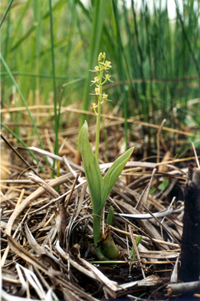Wildlife sightings are a big part of the attraction for many of the sailors and holidaymakers using Barton Broad.
Otters, grebes, kingfishers, terns and many other species can be seen from the water – but tucked away behind the reeds and woods that fringe the broad is a remarkable wildlife haven which has benefitted from a newly completed 18-month restoration project.

Fen orchid
Catfield Fen is a hidden gem, one of the finest examples of tall herb fen in the world. It is reed interspersed with some of the rarest species in the country, such as the fen orchid and marsh fern. Also growing on the fen is the milk parsley, the sole food plant of the rare
swallowtail butterfly’s caterpillar stage, and the fen is home to the
Norfolk hawker dragonfly.
Small turf ponds now dot the landscape, providing a habitat for 44 species of aquatic beetle as well as a nursery for dragonflies.
Catfield Great and Little fens are close to the south east corner of Barton Broad, where the River Ant flows out towards Irstead, How Hill and Ludham, and are managed by Norfolk Wildlife Trust (NWT), which also owns
Barton Broad.
Kirsty Bailey, the trust’s reserves officer for the Broads, coast and wetlands, said that Catfield Fen and the area around it is a rare and special place, rich in biodiversity.
“The area as a whole is one of the finest examples of tall herb fen in the world,” she said. “The reedbeds include species such as fen orchid, marsh fern, milk parsley, round leaved sundew, bladderwort and saw-sedge.”
The future of plants and wildlife on the fen has been enhanced by work carried out thanks to a generous grant of nearly £70,000 from Biffa Award as part of the Landfill Communities Fund.
The project included the removal of scrub during last winter, using contractors and volunteer help. This is allowing fen flora to re-establish in those areas.
As well as hired machinery, the work was aided by the purchase of an 'iron horse’ tracked vehicle which was used to move cut scrub with minimal disturbance to the surface of the fen.

Digger creating turf ponds
Small turf ponds, which replicate the peat cuttings which originally created Barton Broad, are a feature of Catfield Fen and about 30 more have been added as part of the restoration. A digger scraped the shallow ponds, providing habitats for aquatic water beetles, dragonflies and damselflies as well as aquatic plants such as bladderwort – lesser, intermediate and greater bladderwort all occur on site. It is now hoped that fen orchids will colonise areas around the ponds.
The work has been informed by studies which have been carried out as part of the project, including a survey which found 44 species of aquatic beetle on the site and an investigation to see if Catfield would be suitable for the introduction of the rare fen raft spider. Bringing the spider to Catfield is an aspiration for the trust but has not yet been carried out.
Eco-hydrology surveys which used piezometers to record automatically the underground water level of the reserve every 15 minutes during the summer were carried out and this will continue in the future.
Kirsty Bailey said the data would help with the management of the site and create a valuable record of the effects of climate change and developments off the site, such as water abstraction.
The grant from Biffa Award has also enabled the trust to place interpretation boards at Catfield Fen to give visitors information about the wildlife they might see there.
NWT Catfield Fen is in the Ant Broad and Marshes National Nature Reserve in one of the Trust’s Living Landscape project areas. The trust has made major investments here in recent years through land purchase, habitat improvements on reserves and on other land in partnership with landowners and other organisations.
Steve Cox is volunteering for Norfolk Wildlife Trust one day a week for six months on a secondment from his employer, John Lewis and Partners.